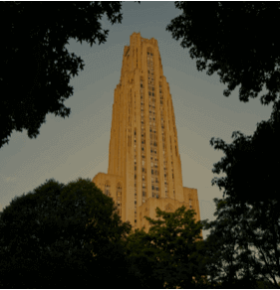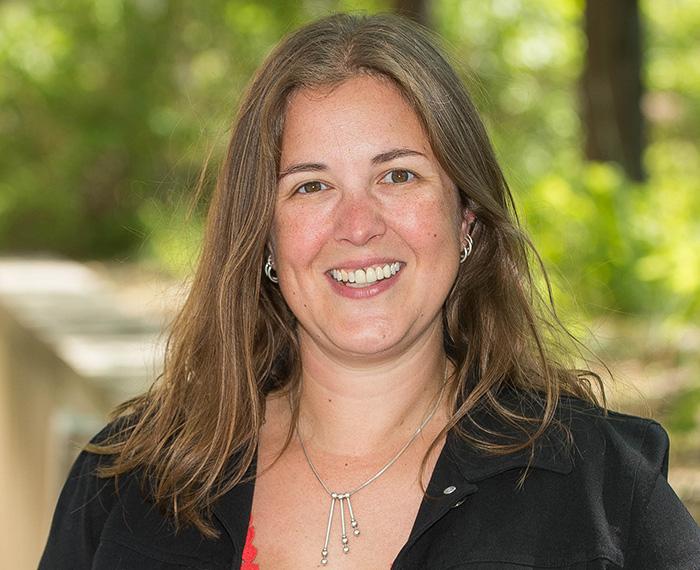
Subscribe to Pittwire Today
Get the most interesting and important stories from the University of Pittsburgh.Q&A: Aurora Sharrard’s personal path to sustainability leader

Since joining the University as its first director of sustainability in 2018, Aurora Sharrard has helped launch initiatives like the POGOH bike share partnership, the Gaucho Solar power purchasing agreement with Vesper Energy and the Pitt Climate Action Plan.
Today, as the inaugural assistant vice chancellor for sustainability, she’s also working behind the scenes with students, staff and faculty to embed sustainability into campus life — whether through rooftop solar panels, zero-waste strategies, or new green spaces like the upcoming Panther Overlook.
In a recent Q&A, Sharrard opened up about her personal experience with sustainability.
This conversation has been edited for conciseness and clarity.
You say sustainability is just ‘something you did’ growing up. What were some of the habits that stuck with you?
My family was very frugal and environmentally minded. We didn’t spend money on extraneous things, we recycled and we did a lot of tent camping. My father often walked to work, and my mother was an elementary science educator.
Even though I grew up in different parts of the country — North Carolina and later Nebraska — our habits stayed consistent. Composting, recycling, thrift shopping … those things became second nature. Even now, when I travel somewhere that doesn’t compost, I find myself wondering what to do with food scraps. It just feels wrong to throw them away when you know they could be used to nourish soil.
You were also a Girl Scout for years. How did that shape your approach to the environment?
A huge part of the Girl Scout experience was learning to leave places better than you found them. That value really stuck with me. My troop did a ton of camping: One of our goals was to earn a badge by visiting every Girl Scout campsite in our region, and we did it. That time outdoors — interacting with nature, seeing new places — shaped how I think about our responsibilities to the environment.
Your parents were clearly a big influence. How has being a parent yourself affected relationship with sustainability?
It’s both reinforcing and challenging. Before my kids were born, we made conscious choices: using cloth diapers and glass bottles and composting everything we could. As they’ve grown up, they’ve worn thrifted clothes, walked or taken public transit to school, and learned to sort items for donation before birthdays or holidays.
They’re also at the age now — 11 and 15 — where they’re curious and asking deeper questions. I love that they’ll come look over my shoulder while I’m working and ask about a chart or a building project. They’re developing their own values and ideas, and it’s exciting to see.
What are some sustainability habits that are second nature to you now?
Honestly, I’ve been building these habits for so long that many of them feel normal. When my husband and I moved to Pittsburgh in 2003, we bought a house in Greenfield because it was walkable, bikeable and close to public transit.
The house was built in 1905, and we’ve done a lot of work, adding insulated walls, efficient lighting and appliances, a heat pump and sustainable materials — all while keeping the building’s historic character.
We’ve also had a Community Supported Agriculture subscription for more than 20 years. We compost, we recycle nearly everything and we’re always thinking about how to reduce waste. These decisions have become our defaults.
You also shared how much you enjoy biking to work. What’s that experience like for you?
That first ride in spring is always the hardest. You have to get all your gear together, and the weather can be unpredictable. But once I’m on my bike, I’m reminded of how much joy it brings. Years ago, I was riding through Schenley Park on a perfect fall day when a deer bounded across the road in front of me. I thought, “This is so beautiful — and I’m still in the city.” That sense of connection to place really motivates me.
What makes Pittsburgh the right place to do sustainability work?
Well, first off, I live here and I’m not moving. But more importantly, Pittsburgh attracts people who want to be here, who love what makes this city unique and who want to make it even better. There’s so much innovation happening here, often quietly. When I worked at Green Building Alliance, I’d give tours to visitors who’d say, “If you can make this happen in Pittsburgh, we can make it happen anywhere.”

